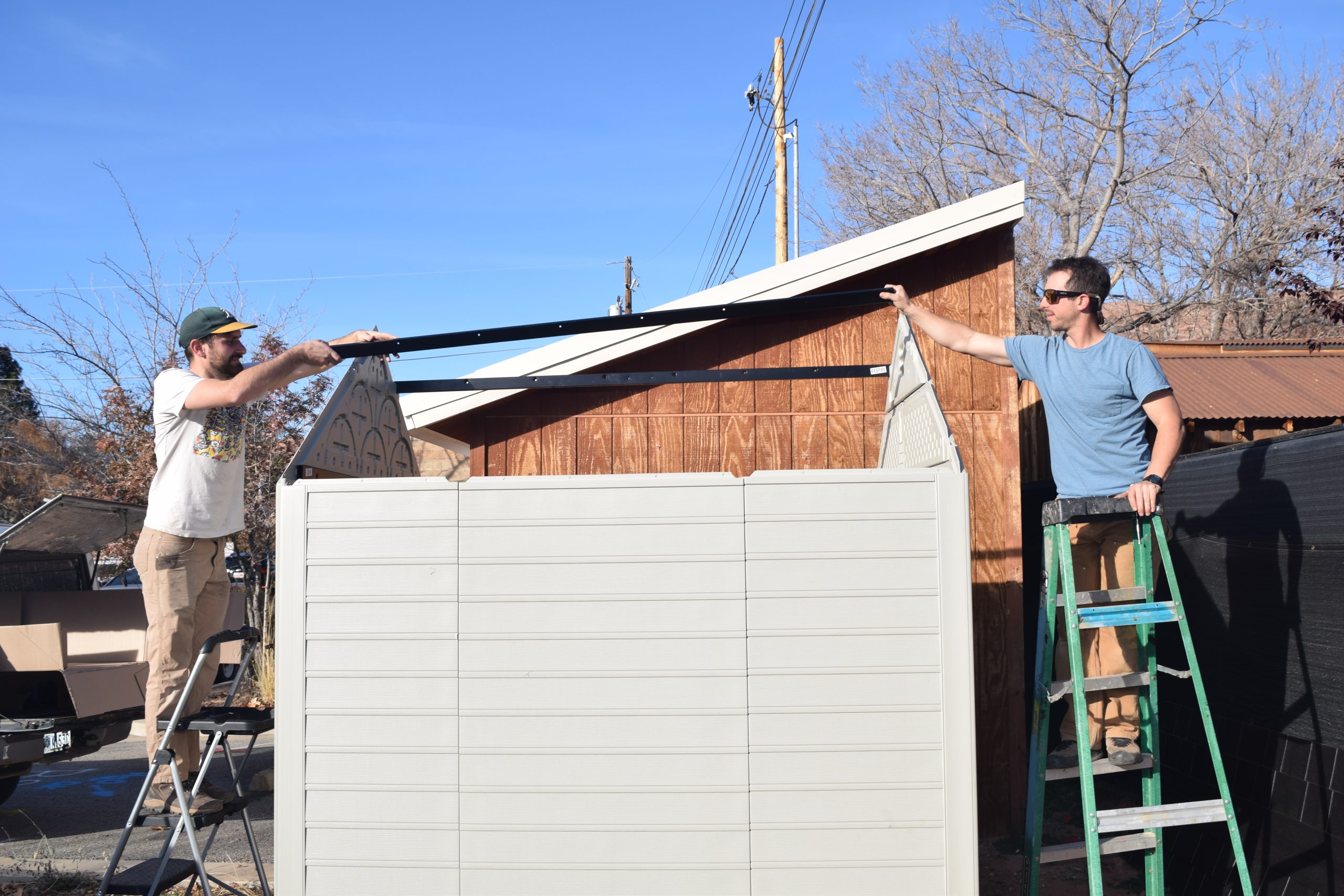Some information may be outdated.
The Grand County Local Homeless Council is creating a new resource for people experiencing homelessness: a supply of items for surviving outdoors, as a stop-gap measure for people who don’t have other options. The items—such as sleeping pads and bags, tents, and cooking stoves—will be stored in a shed at the Grand County Public Library and available to people in need through local service organizations. The shed was installed on Dec. 3, and the LHC has been receiving donations of requested items.
“It’s definitely not a cure, but I think it’s seeing reality and knowing that people are having to live this way,” said Liz Donkersloot, Housing Resource coordinator for the Moab Valley Multicultural Center and member of the LHC. She is spearheading the new project and hopes it will be operating by January.
The idea for the Safe Outdoor Living supply shed came from former VISTA at the Moab Valley Multicultural Center Katie Minehart. Donkersloot said the project was stalled for a time while the group looked for a place to host the shed. In a brainstorming session, the library surfaced as a logical location: it’s a welcoming place that many homeless people already visit to get out of the elements or use services. It also has longer hours than many service organizations like the MVMC.
Library Director Carrie Valdes was supportive of the idea and soon after, the group presented their project to the Moab chapter of the nonprofit 100 Women Who Care. That organization agreed to donate $4,000 to support the Safe Outdoor Living Shed. Some of the money has been used to purchase the shed, shelves and a lock; leftover funds will go toward purchasing supply or an emergency housing fund.
The LHC has set up an online registry for donors to contribute items. Requested items include camp stoves, backpacks, tents, lanterns, headlamps and sleeping bags. The link for the registry is www.dreamlist.com/for/moabcommunitystock. Donors can note what they plan to give on the registry, purchase the item and drop it off at the MVMC.
A local network of nonprofits and service providers will be able to offer vouchers to people who need items from the shed, and library staff can help voucher-holders access what they need. The shed has limited space, so the LHC is starting with requests for four to eight of each item; Donkersloot said they will eventually need to refresh the stock as items are distributed.
There is certainly a need for resources for homeless people in Grand County. Donkersloot said in a Nov. 29 interview on local radio station KZMU that local agencies working with people who are homeless or at risk of homelessness are engaged with 111 people in Grand County; 75 of those people are physically homeless, and 36 are at risk of homelessness. Being “at risk of homelessness,” as the term is used by advocacy groups and policymakers, means homelessness is imminent within 30 days.
“Looking at data, the number that sticks out to me the most is that situational homelessness is 90% of our homeless in Grand County,” Donkersloot said.
“Situational homelessness” is distinct from “chronic homelessness.” Chronic homelessness is a year or more of homelessness, either consecutive or cumulative in a three-year timeframe. Those who are situationally homeless may be homeless for the first time. While stereotypes often marginalize homeless people, in reality, they are often deeply engaged in the communities where they live. They may have families, hold jobs, be enrolled in school or be involved in churches in their communities, even while lacking stable housing. They may be living outside, in vehicles, in storage units or on a friend’s couch.
“Homelessness in Moab isn’t like a city, where it’s in your face,” said Donkersloot. “It’s kind of a quiet homelessness.”
Many factors may put someone at risk of homelessness, including job loss, illness, loss of a spouse or partner, rent going up or a rental property being sold by a landlord. In Moab, even people with multiple jobs may struggle to find and maintain housing, because the local housing stock doesn’t meet the housing need.
“We all know that housing Moab is, one, not always available, and two, not always affordable,” Donkersloot said in her Nov. 29 KZMU interview.
While the Safe Outdoor Living shed is not a perfect solution, it fills an immediate need for resources for people experiencing homelessness. Donkersloot is a member of state-level homeless advocacy boards, and she said when she discussed the concept of the shed with members of that group, people seemed unfamiliar with the idea and intrigued. She hopes it can become a model for other rural areas that may be looking for creative stop-gap solutions.
For Moab’s SOL shed, Donkersloot plans to find someone to paint a sun on the wall, as a play on the project’s sunny acronym. She’s grateful to everyone who contributed to the project getting off the ground.
“It’s been amazing community collaboration,” she said.
“It’s definitely not a cure, but I think it’s seeing reality and knowing that people are having to live this way.” Liz Donkersloot
Appreciate the coverage? Help keep local news alive.
Chip in to support the Moab Sun News.





